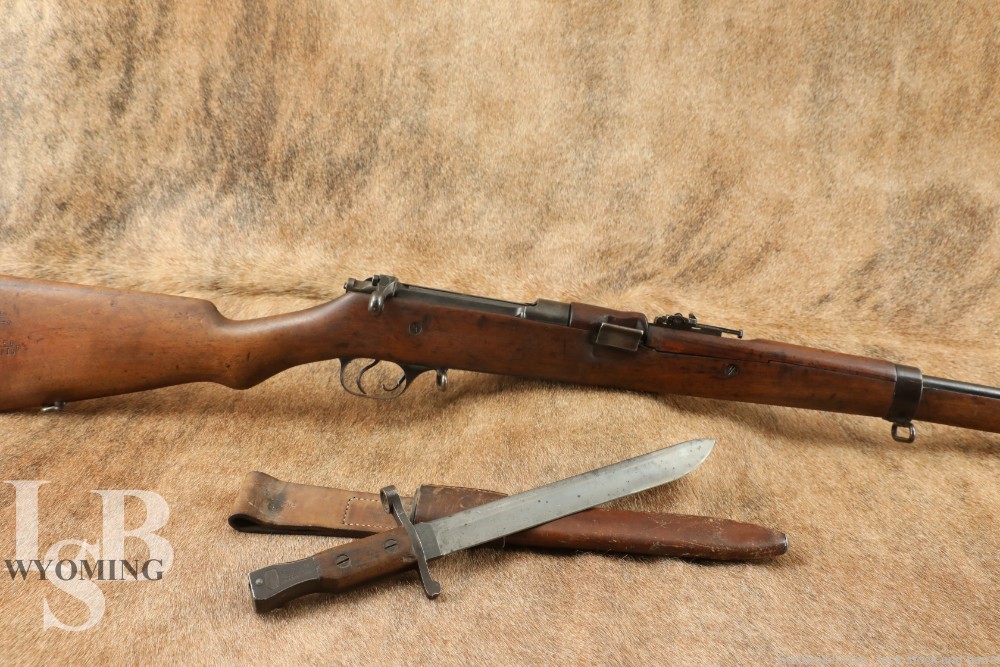
U.S. Marked Canadian Ross Mk. II M1905 Bolt Rifle .303 W/ Bayonet, C&R
SOLD FOR: $1,117.87
LSB#: WY240905SP072
Make: Ross Rifle Co., Canada
Model: M1905 Mk. II
Serial Number: 17092
Year of Manufacture: 1910
Caliber: .303 British
Action Type: Straight pull bolt action, 5 round internal magazine
Markings: The left side of the receiver is marked, “ROSS RIFLE CO. QUEBEC. CANADA. 1905”. The stock has several proofs and markings including the serial number, U.S. proofs under the wrist, date of manufacture, and other small marks. The bayonet is marked, “ROSS RIFLE CO. QUEBEC PATENTED 1907 / 08 10-09” on the bottom. The wood is marked, “590”. The scabbard is marked, “Mk. II”.
Barrel Length: 28”
Sights / Optics: The front sight is a blade set on a barrel mounted base with a protective hood. The rear sight is a flip up U-notch / aperture with fine adjustment.
Stock Configuration & Condition: The stock is a two piece walnut set with a capped forend/bayonet lug w/ stacking loop, barrel band w/ sling loop, two through bolts, semi-pistol grip, straight comb, and steel buttplate with a storage door. There are light pressure dents and scratches throughout. The finish is bubbled and cracked. The top half of the forend and behind the receiver are cracked. There are small chips. There are no cracks. The LOP measures 14” from the front of the trigger to the back of the buttplate. The stock rates in about Very Good overall condition as refinished.
Type of Finish: Hot oil blued, clear coat
Finish Originality: Refinished
Bore Condition: The bore is gray and the rifling is worn. There is moderate to heavy erosion and light pitting in the bore. In this writer’s opinion, this bore rates 4/10.
Overall Condition: This rifle retains about 70% of its metal finish. There is light thinning, patina, and handling marks throughout. There are small spots of refinished over pitting. The bolt and bottom metal have heavy thinning and patina. The action has moderate wear. The screw heads show moderate use. The markings are mostly clear. Overall, this rifle rates in about Very Good condition as refinished. The bayonet is in Very Good condition.
Mechanics: The action functions correctly. We did not fire this rifle. As with all used firearms, a thorough cleaning may be necessary to meet your maintenance requirements.
Box, Paperwork & Accessories: Bayonet.
Our Assessment: The U.S.-marked Canadian Ross Mk. II M1905 is a straight-pull bolt-action rifle known for its precision, unique design, and historical significance. Originally manufactured in Canada by the Ross Rifle Company, the Mk. II was adopted by the Canadian military in the early 20th century and saw service during World War I. U.S.-marked examples hold special interest due to their connection to American military training during that era. The Ross Mk. II is chambered in .303 British, the standard cartridge of the British Commonwealth. The .303 cartridge offered reliable performance with sufficient range and stopping power for infantry engagements. Its rimmed design and proven utility in both rifles and machine guns made it a staple in military service. The design of the Ross Mk. II is centered around its innovative straight-pull bolt action, which allowed the shooter to cycle the bolt directly back and forward rather than requiring a traditional rotary motion. This mechanism enabled rapid cycling of the action, theoretically providing a faster rate of fire compared to standard bolt-action rifles. The rifle features a robust receiver and a five-round internal magazine loaded via stripper clips, typical of military rifles of the time. During World War I, the Ross Mk. II was initially issued to Canadian troops. While it excelled in target shooting, it faced reliability issues in the muddy and harsh conditions of trench warfare, particularly with dirt or debris affecting the straight-pull action. Many Ross rifles were eventually withdrawn from frontline service, but they remained in use for training, sniping, and as reserve weapons.
The U.S.-marked Ross Mk. II rifles were acquired by the United States during World War I for use in military training programs. These rifles, marked with “U.S.” and ordnance acceptance stamps, were used to equip American troops during the rapid expansion of the U.S. Army before sufficient quantities of domestically produced rifles became available. -R.E.
